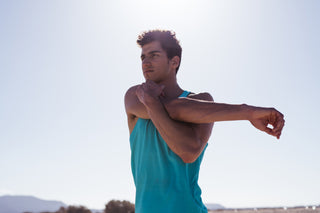Table of Contents
- 1. Quick Anatomy of Chest Muscles
- 2. Difference Between Chest Stretches and Chest Workouts
- 3. Basic Routines of Stretching Chest Muscles
- 4. 11 Best Chest Stretch Exercises
- 4.1. Standing Wall Chest Stretch
- 4.2. Doorway Chest Stretch
- 4.3. Chest Stretches with a Resistance Band
- 4.4. Chest Stretches with a Foam Roller
- 4.5. Cross-body Arm Stretch
- 4.6. Shoulder Roll and Stretch for the Chest
- 4.7. Clasped Hand Chest Stretches
- 4.8. Lying Chest Stretch
- 4.9. Thread the Needle Stretch
- 4.10. Seated Chest Stretch
- 4.11. Pectoral Stretch with a Towel
- 5. Benefits of Chest Stretching Before a Workout
- 6. Conclusion
Performing chest stretches before a chest workout can help increase your range of motion, reduce the risk of injury, and improve overall workout performance. Stretches can help loosen up tight chest muscles and improve the mobility of the shoulders and upper back, allowing you to warm up several chest muscles in preparation for exercises. It can also lead to an improved form, better muscle growth, decrease muscle soreness, and promote faster post-workout recovery.
1. Quick Anatomy of Chest Muscles
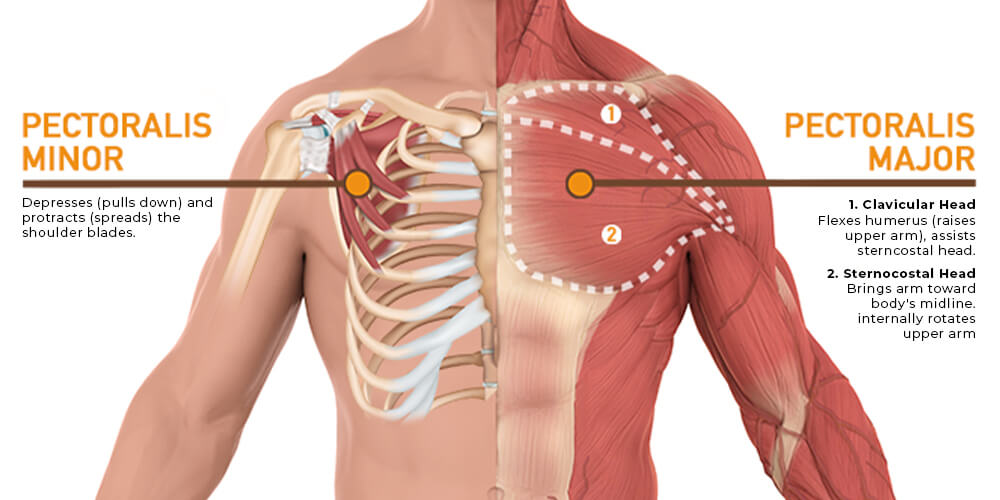
Your pectoral muscles (chest muscles) are located between the neck and upper abdomen. It contains two primary muscles: the pectoralis minor and the pectoralis major.
Pectoralis Minor
The pectoralis minor is located underneath the pectoral major. The primary function of this muscle is to stabilize and control the movement of your shoulder blades (scapulae).
Pectoralis Major
The primary chest muscle is the large pectoralis major. It turns at different angles across the chest area and is attached to two primary points. The first is in the upper chest (clavicular head), and the other is in the lower chest (sternal head).
2. Difference Between Chest Stretches and Chest Workouts
The main difference between chest stretches and a chest workout is that stretches primarily focus on increasing flexibility and range of motion in the chest muscles. In contrast, a chest workout is designed to strengthen and develop the chest muscles.
Chest stretches involve holding a position that stretches the chest muscles, which can help improve mobility, reduce stiffness and soreness, and prepare the chest muscles for a workout.
On the other hand, a chest workout typically involves performing resistance exercises such as bench presses, push-ups, and flies, which target the chest muscles and help increase muscle strength, endurance, and hypertrophy.
While chest stretches can help you warm up before a chest workout, they alone will not be enough to fully develop and strengthen the chest muscles. Incorporating chest stretches and workouts into a training program can help improve overall chest health and fitness.
3. Basic Routines of Stretching Chest Muscles
Keep all the following stretching basics in mind as you perform chest stretches:
- Try to Do Light Cardio When Warm (Never Stretch Cold Muscles)
- Always Try to Maintain a Good Posture
- Do Proper Breathing (In Through the Nose, Out Through the Nose)
- Flowing & Smooth Motions (Never Jerky or Sudden)
- Hold Stretch to the Point of Slight Discomfort; Never Pain
Note: It's important to breathe deeply and relax when stretching, avoiding any bouncing or jerking movements. Additionally, be mindful of any discomfort or pain during the stretch and adjust the position or intensity as necessary.
4. 11 Best Chest Stretch Exercises
Here are 11 chest stretch workout variations that can be incorporated into a warm-up routine:
It's important to note that while these stretches can be effective in promoting chest flexibility and reducing muscle tension, it's recommended you consult a healthcare professional or certified trainer.
4.1. Standing Wall Chest Stretch
Here is how to do a standing wall chest stretch:
- Stand facing a wall with your feet shoulder-width apart.
- Place your palms flat against the wall at shoulder height and shoulder width apart, with your fingers pointing upward.
- Slowly lean your body forward while keeping your arms straight and your feet planted firmly on the ground.
- You should feel a stretch in your chest and the front of your shoulders.
- Hold the stretch for 20-30 seconds and then slowly return to the standing position.
Sets: 2 -3
Repetition: 3- 4
Hold: 0:20 - 0:30 sec
Rest: 0:30 sec
4.2. Doorway Chest Stretch
Here's how to do the doorway stretch:
- Stand in a doorway with your feet shoulder-width apart and your arms at your sides.
- Place your forearms and hands on the door frame, with your elbows bent at a 90-degree angle and your upper arms parallel to the floor.
- Gently step forward with one foot, allowing your body to move forward and your chest to open up.
- You should feel a stretch in your chest and the front of your shoulders.
- Hold the stretch for 20-30 seconds before returning to standing.
- Alternate and repeat this stretch with the other foot forward.
Sets: 2 -3
Repetition: 4 – 5
Hold: 0:20 - 30 sec
Rest: 0:30 sec (or more according to RPE)
4.3. Chest Stretches with a Resistance Band
Here are the steps to do chest stretches with a resistance band:
- Hold the resistance band in both hands and extend your arms out in front of you at shoulder height.
- Keeping your arms straight, slowly move your hands away from each other until you feel a stretch in your chest.
- Hold the stretch for 15-30 seconds.
- Release the stretch and repeat for 2-3 sets.
Sets: 2 -3
Repetition: 6 – 8
Hold: 15 - 30 sec
Rest: 0:30 sec (Or more according to RPE)

Another variation is:
- Attach the resistance band to a sturdy anchor point at about shoulder height.
- Hold onto the ends of the band with both hands and step forward until there is tension in the band.
- Keeping your feet planted, lean forward slightly and allow the band to pull your arms behind your body.
- Hold the stretch for 15-30 seconds.
- Release the stretch and repeat for 2-3 sets.
Sets: 2 -3
Repetition: 6 – 8
Hold: 15 -30 sec
Rest: 0:30 sec (Or more according to RPE)
4.4. Chest Stretches with a Foam Roller
Here are the steps to do chest stretches with a foam roller:
- Lie down on your back with a foam roller under your upper back.
- Bend your knees and place your feet flat on the ground.
- Place your hands behind your head, with your elbows out to the sides.
- Slowly lower your head and upper body towards the floor, allowing the foam roller to roll down your back.
- When you feel a stretch in your chest, hold the position for 15-30 seconds.
- Slowly roll back up to the starting position.
- Repeat the stretch for 2-3 sets.
Sets: 2 -3
Repetition: 6 – 8
Hold: 15 - 30 sec
Rest: 0:30 sec (or more according to RPE)

Alternatively, you can perform a doorway chest stretch using a foam roller:
- Stand in a doorway and place the foam roller horizontally at chest height against one side of the doorway.
- Facing the foam roller, place one foot in front of the other and lean forward slightly.
- Place one hand on the foam roller and lean into the doorway, feeling a stretch in your chest.
- Hold the position for 15-30 seconds.
- Repeat the stretch on the other side of the doorway, using the opposite hand on the foam roller.
- Repeat the stretch for 2-3 sets.
Sets: 2 -3
Repetition: 6 – 8
Hold: 15 - 30 sec
Rest: 0:30 sec (Or more according to RPE)
4.5. Cross-body Arm Stretch
Here are the steps to do a cross-body arm stretch:
- Stand up straight with your feet shoulder-width apart.
- Raise your right arm to shoulder height, parallel to the ground.
- Bend your right arm at the elbow and bring it across your body towards your left shoulder.
- Use your left hand to gently pull your right elbow towards your left shoulder until you feel a stretch in your right shoulder and upper arm.
- Hold the stretch for 15-30 seconds.
- Release the stretch and repeat on the other side, raising your left arm and pulling it across your body towards your right shoulder.
- Repeat the stretch on both sides for 2-3 sets.
Sets: 2 -3
Repetition: 6 – 8
Hold: 15 - 30 sec
Rest: 0:30 sec (Or more according to RPE)
Depending on your preference and flexibility, you can also perform this stretch while seated or lying down.

4.6. Shoulder Roll and Stretch for the Chest
To do a shoulder roll, follow these steps:
- Stand with your feet shoulder-width apart and your arms at your sides.
- Inhale and shrug your shoulders up to your ears.
- Exhale and roll your shoulders back and down, making a circular motion.
- Repeat this motion several times, alternating directions.
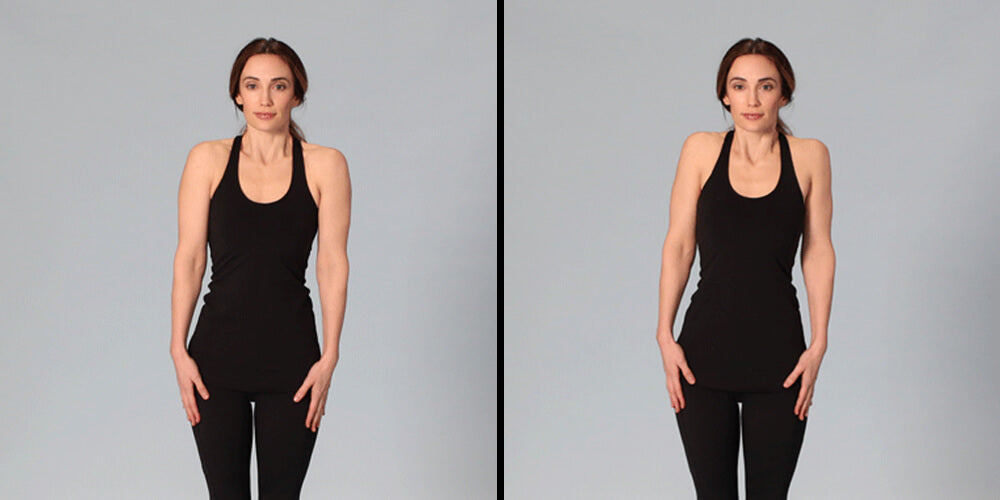
To stretch your chest, follow these steps:
- Stand with your feet shoulder-width apart and your arms at your sides.
- Clasp your hands behind your back, with your palms facing inward.
- Inhale and lift your hands towards the ceiling, keeping your shoulders relaxed.
- Hold the stretch for 10-15 seconds, then release and repeat several times.
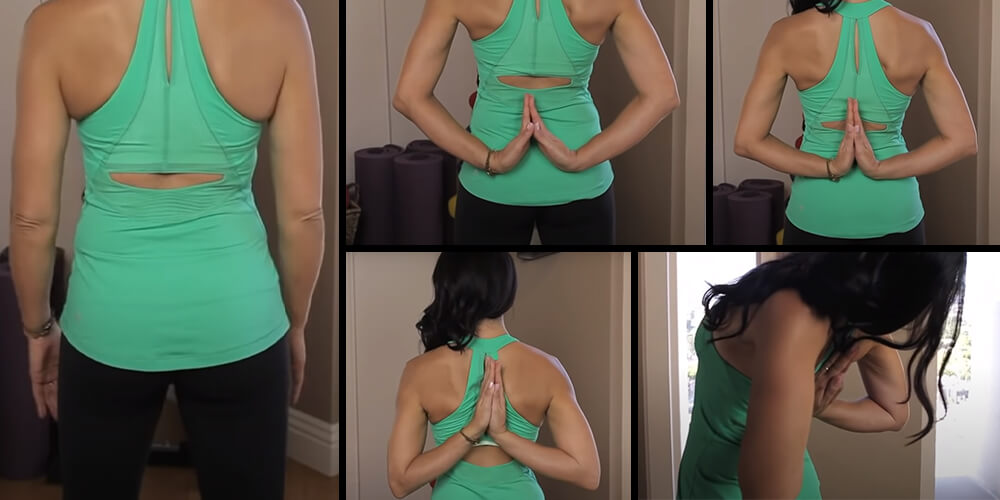
4.7. Clasped Hand Chest Stretches
To do a clasped hand chest stretch, follow these steps:
- Stand tall with your feet shoulder-width apart.
- Bring your hands behind your back and clasp them together.
- Straighten your arms and lift them as far as you comfortably can.
- Feel the stretch in your chest and shoulders.
- Hold the stretch for 15-30 seconds while breathing deeply.
- Release the stretch by slowly lowering your arms back down to your sides.
- Repeat the stretch for several repetitions.
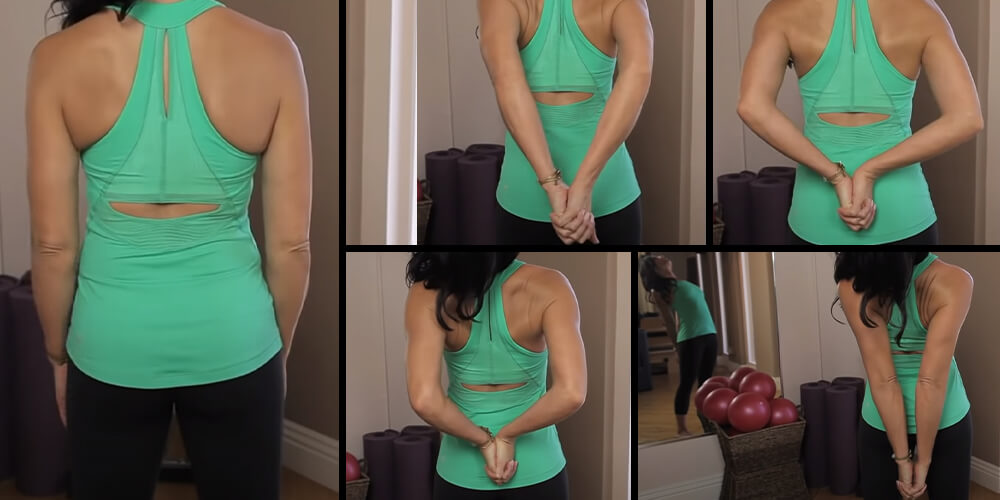
4.8. Lying Chest Stretch
To do a lying chest stretch, follow these steps:
- Lie on your stomach atop a mat or comfortable surface.
- Place your hands on the ground beside your shoulders.
- Keep your hips on the ground and push up with your arms, straightening them fully.
- Your chest should lift off the ground, causing you to feel a stretch in your chest and shoulders.
- Hold the stretch for 15-30 seconds while breathing deeply.
- Lower your chest to the ground and rest for a few seconds.
- Repeat the stretch for several repetitions.
Note: If you feel neck pain or discomfort during the stretch, you can modify the stretch by keeping your chin tucked in towards your chest to protect your neck.

4.9. Thread the Needle Stretch
To do the thread the needle stretch, follow these steps:
- Start on your hands and knees in a tabletop position with your wrists under your shoulders and your knees under your hips.
- Lift your right arm towards the ceiling, twisting your torso to the left.
- Exhale and thread your right arm underneath your left arm, reaching your right shoulder and temple towards the ground.
- Keep your left hand on the ground to help support your weight and maintain your balance.
- Hold the stretch for 15-30 seconds while breathing deeply.
- Release the stretch by lifting your right arm towards the ceiling and returning to the tabletop position.
- Repeat the stretch on the other side by lifting your left arm towards the ceiling, twisting your torso to the right, and threading your left arm underneath your right arm.
- Repeat the stretch for several repetitions on each side.

4.10. Seated Chest Stretch
To do a seated chest stretch, follow these steps:
- Sit on the edge of a chair or bench with your feet flat on the ground.
- Interlace your hands behind your back with your palms facing each other.
- Inhale and lift your chest up towards the ceiling.
- Exhale and gently pull your hands away from your back, straightening your arms and feeling the stretch in your chest.
- Hold for 15-30 seconds while breathing deeply.
- Release by relaxing your hands and returning to a neutral position.
- Repeat the stretch for several repetitions.

4.11. Pectoral Stretch with a Towel
To do a pectoral stretch with a towel, follow these steps:
- Hold a towel with both hands behind your back.
- Extend your arms straight out behind you, keeping your hands shoulder-width apart.
- Gently lift the towel towards the ceiling to feel the stretch in your chest.
- Hold for 15-30 seconds while breathing deeply.
- To increase the stretch, gently pull the towel toward your head.
- Release the stretch by lowering the towel and returning to a neutral position.
- Repeat the stretch for several repetitions.
Note: Make sure to use a towel or strap that is long enough to comfortably hold with both hands behind your back without straining your shoulders or upper back. Stop and adjust the towel to a more comfortable position if you experience any pain or discomfort during the stretch.

5. Benefits of Chest Stretching Before a Workout
Performing chest stretches before a workout can provide a range of benefits, including:
Increased Flexibility:
Chest stretches can help improve flexibility and range of motion in the chest muscles, improving exercise form and technique during chest exercises.
Reduced Risk of Injury:
Tight chest muscles can increase the risk of injury during chest exercises. Stretching can help reduce muscle tension and increase blood flow, decreasing the likelihood of injury.
Improved Muscle Activation:
Stretching can help activate and engage the chest muscles, improving muscle activation during chest exercises.
Enhanced Performance:
By improving flexibility, reducing tension, and increasing muscle activation, chest stretches can improve overall performance during chest workouts, potentially leading to better strength and muscle gains.
Decreased Muscle Soreness:
Chest stretches can help to reduce muscle soreness and promote post-workout recovery by increasing blood flow and reducing muscle tension.
Overall, incorporating chest stretches into a warm-up routine can better prepare the chest muscles for a workout and maximize the benefits of training.
6. Conclusion
The chest is a major muscle group that affects your entire upper body. Performing a chest stretch on a daily basis will greatly benefit your workout regimen. Moreover, a good stretching routine doesn’t take long and should be central to any overall workout routine. Lastly, remember to only stretch warm muscles, keep stretching slowly and controlled, and never do sudden or jerky movements. Follow all of the stretch variations mentioned above and work your chest muscles.
"This article is originally posted on borntough.com, and borntough.com own the sole copyright on this article. If you read this article outside borntough.com, please report this website to the authority because they have stolen the content from borntough.com and violated borntough copyright"
